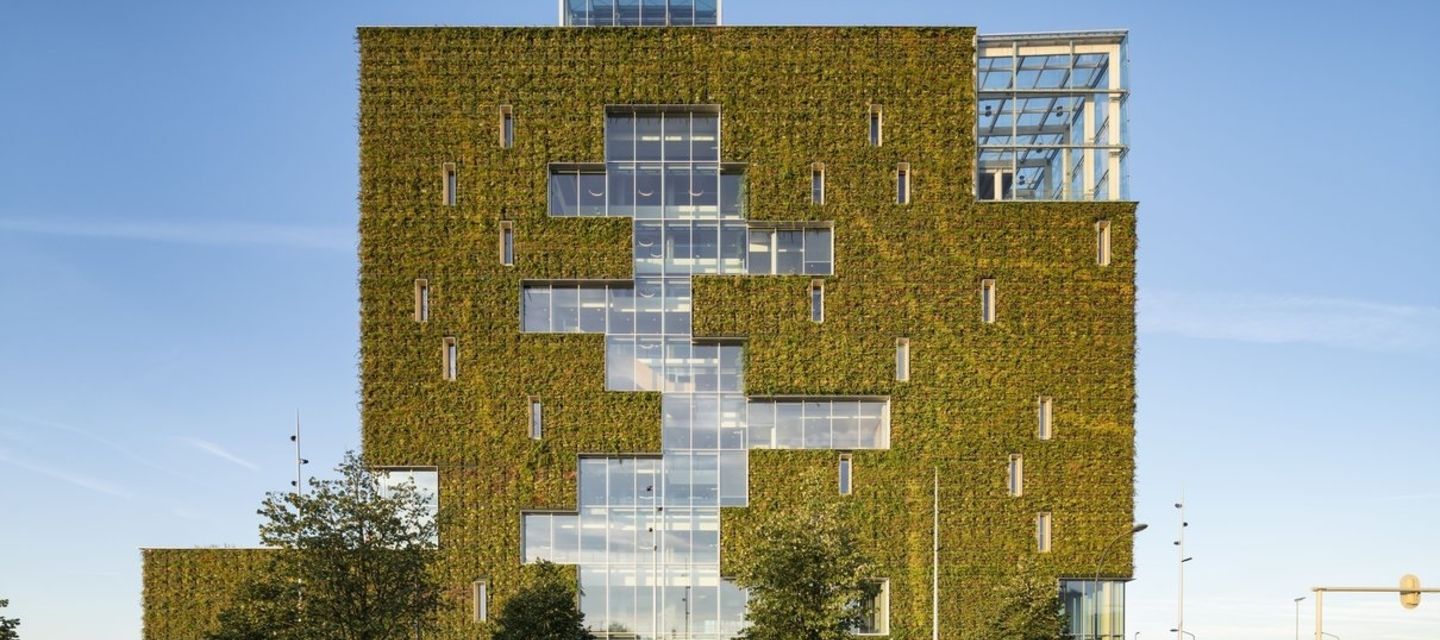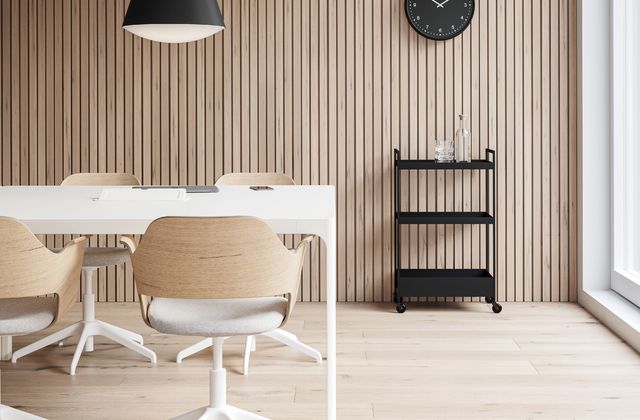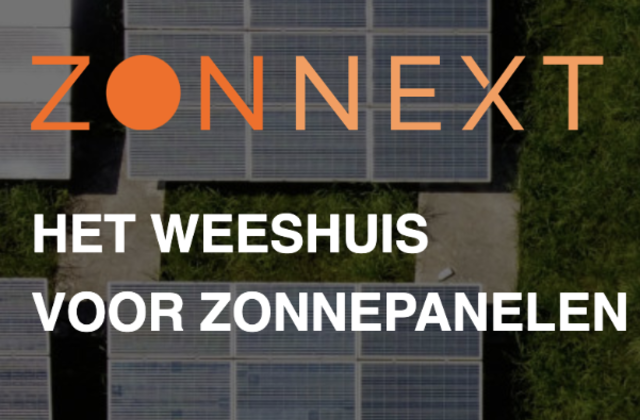What is it? Architecture firm Kraaijvanger was commissioned by the municipality of Venlo to design its new City Hall based on cradle-to-cradle design principles.
Why is this important? The buildings and construction sectors together consume 40% of all the materials entering the global economy (Khasreen et al., 2009), and also account for 36% of global final energy use (UN Environment & International Energy Agency, 2017). Buildings typically have long lifetimes, use significant amounts of heavy materials such as concrete, stone and steel and can create large amounts waste at the end of their lifetimes (Allwood et al., 2011; Holland Circular Hotspot, 2018). With an increasing global urban population, there is a growing need to both construct new sustainable buildings, as well as retrofit old structures (Eline et al., 2018). Therefore, it is important to innovate towards a circular construction economy incorporating ideas such as modular and regenerative design, material passports, buildings-as-a service, design for disassembly and material banks (Eline et al., 2018; Holland Circular Hotspot, 2018).
Main resource strategy: Closing the loop by designing a cradle-to-cradle building. All the materials in the city hall have a materials passport to help track them at the end of life (Kraaijvanger, 2020).
Other resource strategies:
- Narrowing the loop by constructing the building to be a temporary raw materials bank and implementing materials passports (Kraaijvanger, 2020).
- Regenerating the loop by having a green façade and rooftop greenhouses that purify the air around the building and reuse the rainwater (Kraaijvanger, 2020).
Business model aspects: The Municipality of Venlo commissioned Kraaijvanger to design its new City Hall with circularity in mind.
- Value Proposition: Providing a circular building to the residents of Venlo.
- Value Creation & Delivery: The building is like a “vertical city park” that cleans the air around it, recycles the water, and increases local biodiversity, while at the same time providing open, collaborative, functional and adaptive workspaces to the municipality (Kraaijvanger, 2020).
- Value Capture: A circular working space for the Municipality of Venlo that also acts as a temporary materials bank for many of the products used in construction (ArchDaily, 2020; Kraaijvanger, 2020).
Business model experimentation practices: Kraaijvanger has been experimenting with circular buildings and sustainable building materials since 1994, with Ecotopia being their first energy-neutral building (Kraaijvanger, 2021b). The company has a vision to innovate towards buildings that are like trees, “purifying the air and the water, supplying energy and raw materials for reuse” (Kraaijvanger, 2021a).
Sustainability outcomes: The green façade of the building contributes to increasing the biodiversity of the area and has more than 100 different plant species. The façade also filters 30% of NOx, SO3, and particulate matter from the motorways near it, while also contributing to natural air conditioning and climate control. The heat collected by the greenhouses on top of the building are used for heating, and the greenhouses also filter rainwater which is then used for water the green façade and for flushing toilets. The building is also designed to maximize natural daylight in order to minimize energy consumption (ArchDaily, 2020; Kraaijvanger, 2020).
Image Source: Kraaijvanger. (2020). City Hall Venlo. Accessed 14 December 2020 at: https://www.kraaijvanger.nl/en/projects/city-hall-venlo/
Sources:
Allwood, J. M., Cullen, J. M., Carruth, M. A., Cooper, D. R., McBrien, M., Milford, R. L., Moynihan, M.C., & Patel, A. C. H. (2011). Sustainable materials: With both eyes open. UIT Cambridge. ISBN: 978-1-906-86005-9. URL: http://www.withbotheyesopen.com/
ArchDaily. (2020). Stadskantoor Venlo / Kraaijvanger Architects. Accessed 17 December 2020 at: https://www.archdaily.com/872129/stadskantoor-venlo-kraaijvanger-architects
Eline, L., Quist, J. N., & Bocken, N.M.P. (2018). Circular Economy in the building sector: Three cases and a collaboration tool. Journal of Cleaner Production. 176, p. 976-989. DOI: https://doi.org/10.3390/su1030674
Holland Circular Hotspot. (2018). Circular Construction Economy. URL: https://hollandcircularhotspot.nl/wp-content/uploads/2019/09/Circular-Construction-Economy.pdf
Kraaijvanger. (2020). City Hall Venlo. Accessed 14 December 2020 at: https://www.kraaijvanger.nl/en/projects/city-hall-venlo/
Kraaijvanger. (2021a). Circular Building. A second life is always a new beginning. Accessed 03 February 2021 at: https://www.kraaijvanger.nl/en/expertise/circular-building-design-and-architecture/
Kraaijvanger. (2021b). Expertise. Accessed 03 February 2021 at: https://www.kraaijvanger.nl/en/expertise/
Khasreen, M.M., Banfill, P.F.G., & Menzies, G.F. (2009). Life-Cycle Assessment and the Environmental Impact of Buildings: A Review. Sustainability. 1(3), p. 674-701. DOI: https://doi.org/10.3390/su1030674
UN Environment and International Energy Agency. (2017). Towards a zero-emission, efficient, and resilient buildings and construction sector. Global Status Report 2017. Available at: https://www.worldgbc.org/sites/default/files/UNEP%20188_GABC_en%20%28web%29.pdf
***
About project Circular X
Project Circular X is about ‘Experimentation with Circular Service Business Models’. It is an ambitious research project funded by the European Research Council (ERC) which supports top researchers from anywhere in the world. Project CIRCULAR X runs from 2020-2025. The project is led by Principal Investigator (PI) Prof Dr Nancy Bocken, who is joined by a multidisciplinary team of researchers at Maastricht Sustainability Institute (MSI), Maastricht School of Business and Economics, Maastricht University. The project cooperates with businesses who want to innovate towards the circular economy.
Project Circular X addresses a new and urgent issue: experimentation with circular service business models (CSBMs). Examples of such new business models include companies shifting from selling products to selling services and introducing lifelong warrantees to extend product lifetimes. However, CSBMs are far from mainstream and research focused on experimentation is little understood. The research aims to conduct interdisciplinary research with 4 objectives:
- Advancing understanding of CSBMs; their emergence and impacts
- Advancing knowledge on CSBM experimentation
- Developing CSBM experimentation tools
- Designing and deploying CSBM experimentation labs
Funding source
This project has received funding from the European Research Council (ERC) under the European Union’s Horizon 2020 research and innovation programme, grant agreement No. 850159.
Using of this information
When you refer to this case, please use the following source:
Circular X. (2021) Case study: City Hall Venlo. Accessed from www.circularx.eu



